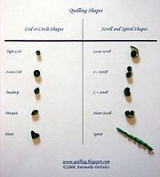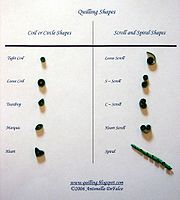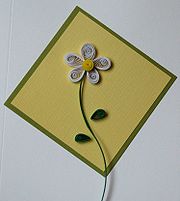
Quilling
Encyclopedia


Art
Art is the product or process of deliberately arranging items in a way that influences and affects one or more of the senses, emotions, and intellect....
form that involves the use of strips of paper
Paper
Paper is a thin material mainly used for writing upon, printing upon, drawing or for packaging. It is produced by pressing together moist fibers, typically cellulose pulp derived from wood, rags or grasses, and drying them into flexible sheets....
that are rolled, shaped, and glued together to create decorative designs. The paper is wound around a quill to create a basic coil shape. The paper is glued at the tip and the coil shaped, these shaped coils are arranged to form flowers, leaves, and various ornamental patterns similar to ironwork.
During the Renaissance
Renaissance
The Renaissance was a cultural movement that spanned roughly the 14th to the 17th century, beginning in Italy in the Late Middle Ages and later spreading to the rest of Europe. The term is also used more loosely to refer to the historical era, but since the changes of the Renaissance were not...
, French
France
The French Republic , The French Republic , The French Republic , (commonly known as France , is a unitary semi-presidential republic in Western Europe with several overseas territories and islands located on other continents and in the Indian, Pacific, and Atlantic oceans. Metropolitan France...
and Italian
Italy
Italy , officially the Italian Republic languages]] under the European Charter for Regional or Minority Languages. In each of these, Italy's official name is as follows:;;;;;;;;), is a unitary parliamentary republic in South-Central Europe. To the north it borders France, Switzerland, Austria and...
nuns and monks used quilling to decorate book covers and religious items. The paper most commonly used was strips of paper trimmed from the gilded
Gilding
The term gilding covers a number of decorative techniques for applying fine gold leaf or powder to solid surfaces such as wood, stone, or metal to give a thin coating of gold. A gilded object is described as "gilt"...
edges of books. These gilded paper strips were then rolled to create the quilled shapes. Quilling often imitated the original ironwork
Ironwork
Ironwork is any weapon, artwork, utensil or architectural feature made of iron especially used for decoration. There are two main types of ironwork wrought iron and cast iron. While the use of iron dates as far back as 4000BC, it was the Hittites who first knew how to extract it and develop weapons...
of the day.
In the 18th century, quilling became popular in Europe where gentle ladies of quality ("ladies of leisure") practiced the art. It was one of the few things ladies could do that was thought not too taxing for their minds or gentle dispositions. Quilling also spread to the Americas and there are a few examples from Colonial times.
Many quilled art works can be found on cabinets and stands, cribbage boards, ladies' purses, a wide range of both pictures and frames, work baskets, tea caddies, coats of arms and wine coasters. Storage boxes, larger than most jewelry boxes with drawers and/or tops that opened, quilled lock boxes, and much more. Some items were specially designed for quilling with recessed surfaces. Quilling was also combined or married with other techniques such as embroidery and painting.
The craft has gone through many transformations and changes through the ages using new techniques, styles and materials. Dimensional quilling creates 3D items.
Today, quilling is seeing a resurgence in popularity with quillers (people who practice the art of quilling) on every continent and in every walk of life. No longer confined to the "upper classes", this is a peoples art form and the beauty of the art is always expanding. The craft has become increasingly popular due to the low cost of the material. It is used to decorate wedding invitations, birth announcements, greeting cards, scrapbook pages, and boxes. Quilling can be found in art galleries in Europe and in the United States and is an art that is practiced around the world.
Quilling Paper Types
Quilling paper is available on the consumer market in over 250 colors and dimensions. It can be divided into various categories, like solid colored Quilling paper, graduated Quilling paper, two-tone Quilling paper, acid free Quilling paper and other assorted parcels of Quilling paper. It is available in various dimensions, such as 1/8”, ¼” and 3/8 broad paper parcels.Acid-Free Quilling paper:
As the name clearly indicates this is a paper that is completely acid free. The quality makes it an outstanding choice for making scrapbooks, rubber stamping, and creating frames for pictures. It assures your project will last a lifetime, without any side effects on the framed picture or album.
Graduated Quilling Papers:
This type of paper provides you an exceptional look to your decorative quilling projects. On the edges, you will have a solid, concrete color but gradually, it will fade to white. It is the nature of the quilling ring, that, when using a graduated paper, it begins with a dark shade but ends up being faded to a lighter side. On the contrary, some graduated papers begin as white, or a lighter shade, and then slowly fades into a solid, darker color.
Two-Tone Quilling Papers:
This is another important type of quilling paper. It is quite similar to the graduated quilling paper in its use. The look consists of a concrete color on one side and comparatively lighter color on the other side. Although, with two-tone paper, the color remains same, however, the intensity of color is different. The main use of this quilling paper is to provide a desired level of softness to the quilled subject. It possesses the capacity to quill many papers in a single spiral.
Further reading
- Rolled, Scrolled, Crimped, and Folded: The Lost art of Filigree Paperwork, by Melinda Florian and William James Papp, Jr. Papp. 50 pages of information and pictures of antique works of art.

